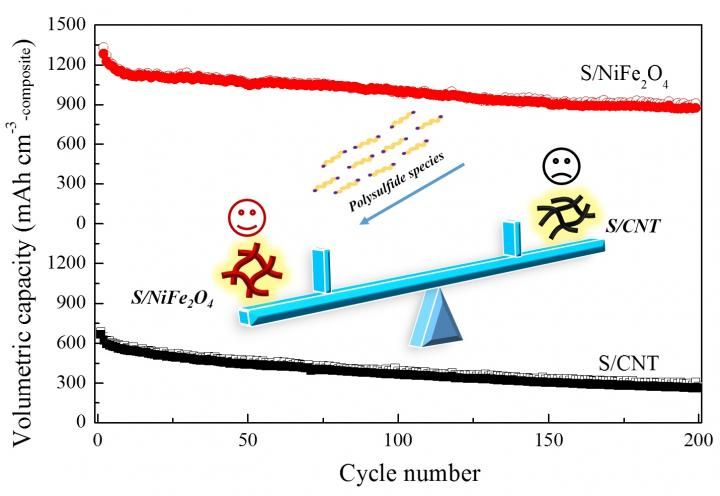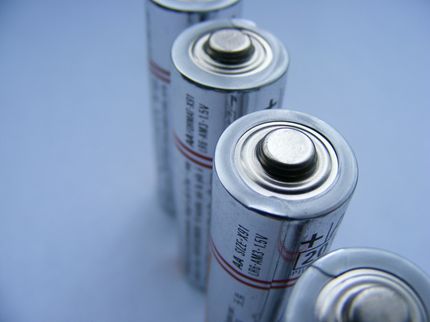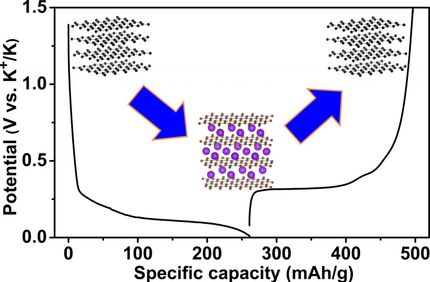Nickel ferrite promotes capacity and cycle stability of lithium-sulfur battery
Lithium-sulfur (Li-S) battery can be put into practice, if 20% of theoretical energy densities (2600 Wh/kg or 2800 Wh/L) can be achieved. Investigators have the ambition to reach the energy density of 500 Wh/kg in the near future.

Compared to S/CNTs, S/NiFe2O4 has higher volumetric capacity and cycling stability.
©Science China Press
Xue-Ping Gao and co-workers, from Nankai University, tell us "Till now, the volumetric energy density of 500 Wh/L is not satisfied. But it was already realized in commercial lithium-ion batteries (LIBs) many years ago." They emphasize, "The low volumetric energy density is a bottleneck of practical Li-S battery."
Intrinsically, sulfur has lower density than transition metal oxides as cathode in LIBs. Worse, in order to improve the electrochemical performance, sulfur is usually forced to load onto various light-weight carbon hosts, leading to more lower volumetric capacity of sulfur-based composites, and undermining the volumetric energy density of Li-S battery.
Compared with various carbon materials, heavy metal oxides not only offer good adsorption ability of polysulfides to suppress the shuttle effect, but also help to obtain dense sulfur-based composites with high tap density, which could be the primary reason for realizing both the good stability and high volumetric capacities of sulfur-based composites.
Gao introduces, "Based on above consideration, we developed nickel ferrite (NiFe2O4) porous hollow 1D nanofibers via electrospinning technology. The as-prepared NiFe2O4 nanofibers were used here as a novel host of sulfur in order to increase the volumetric capacity of sulfur-based composites."
Gao details their experiment, "Firstly, the polysulfide adsorption test reveals the strong chemisorption towards soluble polysulfides by NiFe2O4." Both the stable adsorption geometry and adsorption energy of Li2S8 on (111) plane of NiFe2O4 are confirmed by Density Functional Theory (DFT) calculation as compared with carbon nanotubes (CNTs).
As a result, the S/NiFe2O4 composite delivers an initial discharge capacity of 963.6 mAh/g, and good cycle stability. "Furthermore," he said, "the S/NiFe2O4 composite shows nearly 2 times higher superior volumetric capacity than S/CNT composite."
Gao points out, "It comes no surprise that the S/NiFe2O4 composite has much larger the tap density than the S/CNT composite."
In addition, other metal ferrites MFe2O4 (M = Co, Mg, Zn) have also been investigated as polar host of sulfur, and the results confirm the superiority of metal ferrites in fabricating sulfur-based composites with high gravimetric/volumetric capacities for the potential application of Li-S batteries with high gravimetric/volumetric energy density.
Original publication
These products might interest you
See the theme worlds for related content
Topic World Battery Technology
The topic world Battery Technology combines relevant knowledge in a unique way. Here you will find everything about suppliers and their products, webinars, white papers, catalogs and brochures.

Topic World Battery Technology
The topic world Battery Technology combines relevant knowledge in a unique way. Here you will find everything about suppliers and their products, webinars, white papers, catalogs and brochures.
































































